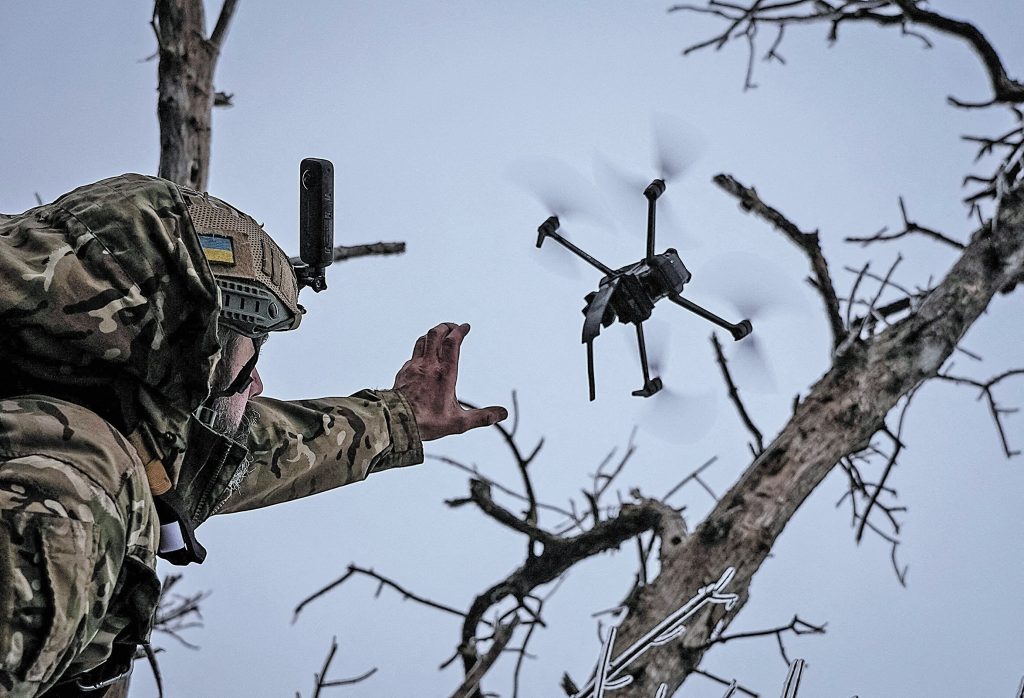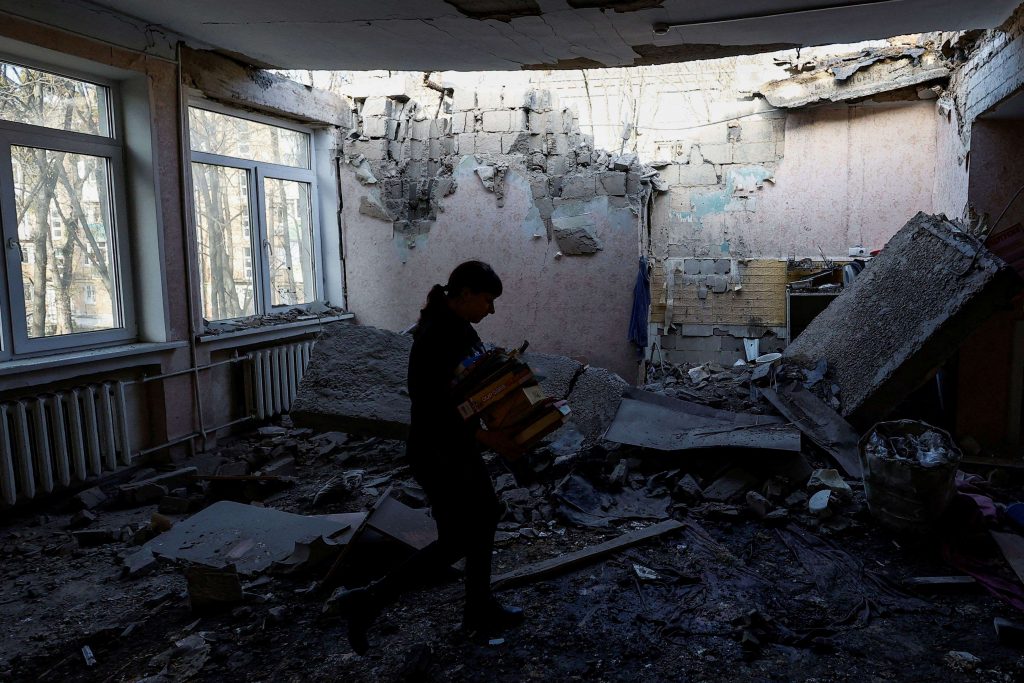TORETSK, Ukraine—On any single day, up to 20 Russian drones can fly over Yevhen Shovkovplyas’s front-line position in Ukraine, and his aging battery of Soviet-era antiaircraft guns has to stop them.
As drones take an increasingly prominent role in modern warfare, the need to bring them down is growing in importance.
Air defense was once the domain of specialist units with expensive equipment to destroy aircraft and missiles. Now, the proliferation of small, cheap drones is spreading the role throughout militaries, prompting governments and arms makers to work to boost their capabilities.
Pentagon acquisition chief Bill LaPlante said last week that the U.S. needed a surge in production of counterdrone technology, and that a lack of such equipment was hampering operations in both Ukraine and Israel.
“We need lots of money, we need production lines to go up fast,” he said.

Ukrainian serviceman launches a kamikaze FPV drone at a front line near the city of Bakhmut, Ukraine, December 12, 2023
To defeat Russian drones, the U.S. and its allies have sent Kyiv missiles, radar-operated cannons and so-called electronic-warfare equipment that scrambles signals.
However, the White House has warned that the U.S. will be unable to continue providing more weapons and equipment to Ukraine if Congress doesn’t approve additional funding by the end of the year. Earlier this month, Republicans in the Senate blocked a Ukraine aid bill that earmarked funds for military support.
Foreign kit is already stretched thin along a 750-mile front line, to the extent that Shovkovplyas and other Ukrainian soldiers here haven’t seen any of it.
Shovkovplyas, a battery commander in Ukraine’s 28th Mechanized Brigade, uses decades-old ZU-23-2 antiaircraft guns to help bring down drones, or “birds,” that stream over Ukrainian lines.
“It’s a cat-and-mouse game,” he said. “Who can shoot down more of the other’s birds,” he said.
Members of Shovkovplyas’s unit say you can never have enough equipment to take out drones, because there are so many of them.
While Ukraine has successfully used drones since the early weeks of the war, Russia has improved its capabilities. It too has adapted cheap commercial drones to carry explosives, its Lancet exploding drone has proven deadly on the battlefield and its fleet of reconnaissance drones have allowed the country to target Ukrainian positions with artillery.
Russia is also expanding its capacity to make drones. It is building a factory to produce Iran’s long-distance Shahed craft and setting up an industrial park outside Moscow to house 17 companies that mostly manufacture drones.
“They are like bees,” said the commander of a Ukrainian artillery unit operating in the Kreminna Forests, in eastern Ukraine. Positions like his have been key targets for Russian drones.
Ukraine has several layers of defense to counter the growing aerial threat.
At front-line trenches, some soldiers say they use electronic-warfare guns, which interfere with a drone’s signals, and resemble “blasters” from sci-fi movies. In the absence of sophisticated weaponry, soldiers say they try their luck with assault rifles.
Several miles back are the 28th Mechanized Brigade’s antiaircraft guns, whose operators use a series of pedals and handlebars to line up two sights on targets.
Despite the big gun’s age “it does its work pretty well,” said one operator, whose callsign is Alpha.
Alpha said he has seen up to 20 Lancet drones fly in his area on one day, though typically he would see one or two. Cloud cover is the most effective counterdrone measure, he added.
Russia is changing its drone tactics, the brigade’s members say. Lancets used to travel solo, for instance, but can now come in pairs.
“The principle is that if one Lancet gets intercepted, the second one keeps flying,” said Shovkovplyas, the battery commander.
Military analysts and Ukrainian troops say that Russia may have the edge when it comes to electronic warfare to counter drones.
Ukraine is losing around 10,000 drones a month, the Royal United Services Institute, a military think tank, said in a May report. Russia has at least one major electronic-warfare system for just over every 6 miles of front, according to the report.
Russia has been very effective at bringing Ukrainian drones down by sending out a more powerful signal to control the drone than its actual operator, said James Patton Rogers, an expert in these vehicles at the Cornell Brooks Tech Policy Institute at Cornell University.
This ability to jam drone signals means that Ukrainian operators have to move closer to the front line to maintain signal with their unmanned aerial vehicles, Rogers said.
Ukraine knows its own electronic warfare needs to catch up.
“This is a very serious part of our front-line defense…we didn’t pay attention to this as much as we had to,” said Anna Gvozdiar, deputy minister for strategic industries. Building its own counterdrone systems is now a priority for Ukraine, she added.

An employee carries items inside a building of a kindergarten damaged during Russian drone strikes in Kyiv, November 25, 2023.
Ukrainian forces are already using some locally made devices, including a shoebox-size machine that emits an electronic signal to disrupt the connection between an enemy drone and its controller.
The Oberih, or Amulet, resembles a shield and was made by taking apart Chinese antidrone devices and figuring out how they work, said Dmytro Sheinert, its developer. The device, which costs the equivalent of $3,600, works well against small drones used for reconnaissance or adapted to drop grenades, Sheinert said. It can also target racing drones but requires a skilled operator as those craft dive in low and fast, he added.
Drones can be shot down by missile-defense systems that the West has sent Ukraine, including the Patriot, Nasams and Iris-T. But they are an expensive option. Patriot missiles can cost $3 million each and some commercial drones can be bought for just hundreds of dollars.
Given the speedy development of drone warfare, many of the systems being pushed out to stop them are new.
Earlier this year, the U.S. sent Ukraine 14 new counterdrone weapons called Vampires, a missile system made by L3Harris Technologies. The system can be fitted onto pickup trucks and hits targets with laser-guided missiles.
In August, Norwegian arms maker Kongsberg began delivering several counterdrone systems called CORTEX Typhon to Ukraine. Development of the weapon, which fires shells and is operated remotely, only finished this year. Its design was in part influenced by what was happening in Ukraine, including the need to make it easy to operate so that crews could be trained quickly, said Eirik Lie, president of Kongsberg’s defense and aerospace business.
Israel also requires more equipment, according to a defense consultant who has advised the country. During the recent conflict, Hamas has attacked Israeli positions with explosive-laden drones.
A pioneer of counterdrone technology, Israel’s arsenal includes Rafael Advanced Defence Systems’ so-called Iron Beam weapon, which uses a laser to disable drones from hundreds of feet to several miles up in the air.
Back at the Ukrainian front, counterdrone operators have to be nimble and move on as soon as they have shot down a Russian drone.
“When you have destroyed your enemy’s bird then the artillery shelling follows,” said Shovkovplyas.
—Oksana Grytsenko, Kate Vtorygina and Doug Cameron contributed to this article.
Write to Alistair MacDonald at Alistair.Macdonald@wsj.com



